Lead Scoring: What It is, Criteria, Models & Best Practices
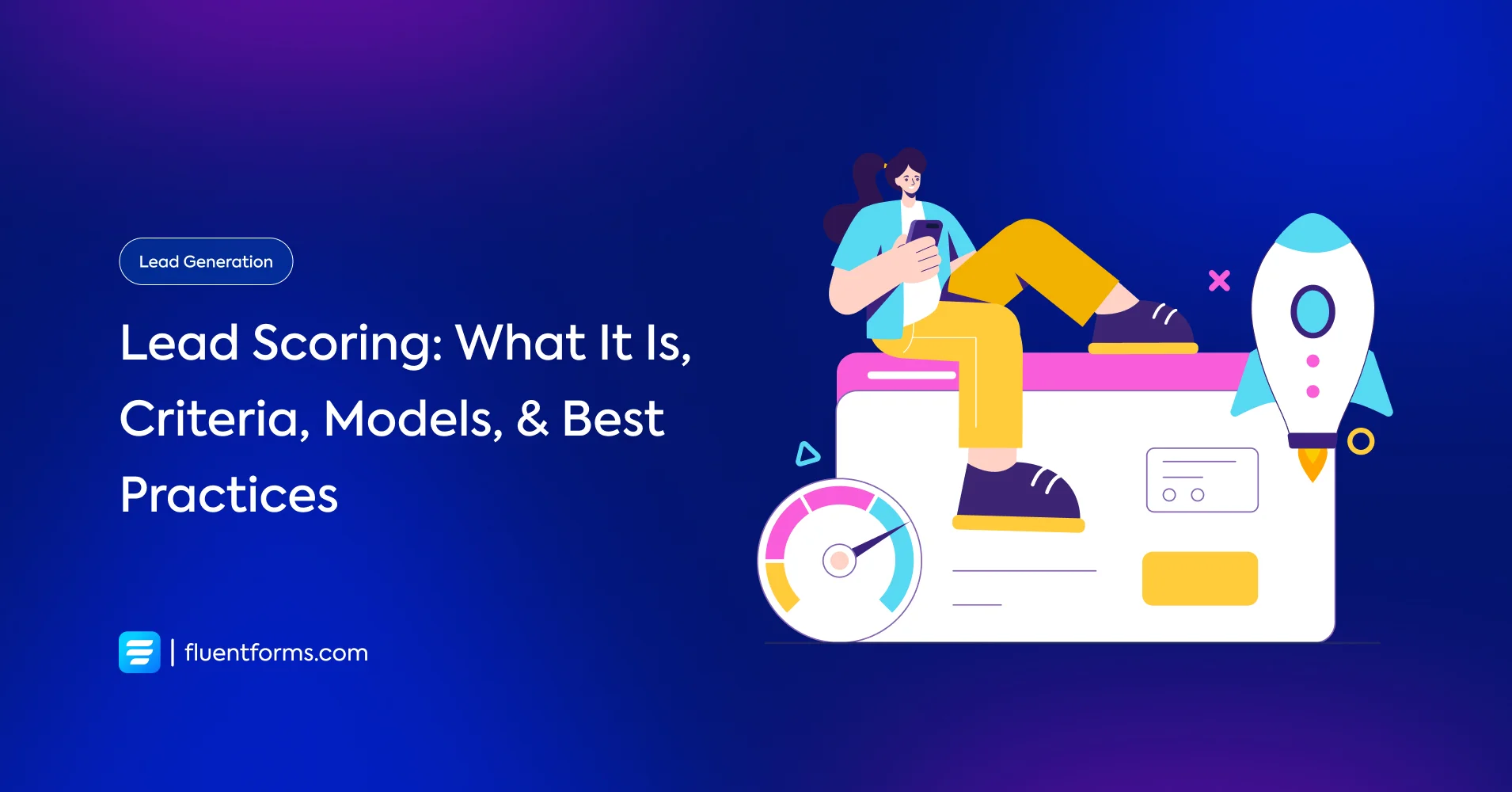
Whoever invented exams said it’s only to find and help students who are lagging behind. We don’t know if they’re keeping their promise anymore, but this was an incredible invention, at least for your sales process.
Lead scoring is basically an exam to qualify your leads. You give them points based on their data and the actions they take regarding your company. The leads who score the most are most qualified to be your customers.
Let’s say you set twenty criteria to compare your leads and assign five points to a lead for qualifying in a single criterion. This means the total marks for your lead scoring is a hundred, and someone scoring between eighty and a hundred (any number you see fit) can be called sales-ready.
And as a bonus, you actually get to nurture the leads who score comparatively less. Well, someone needs to keep the promise!
Let’s walk you through the lead scoring process in the following sections. Read carefully so you know the right lead scoring criteria for your business and how to use them to develop the perfect lead scoring model for your business.
What is lead scoring
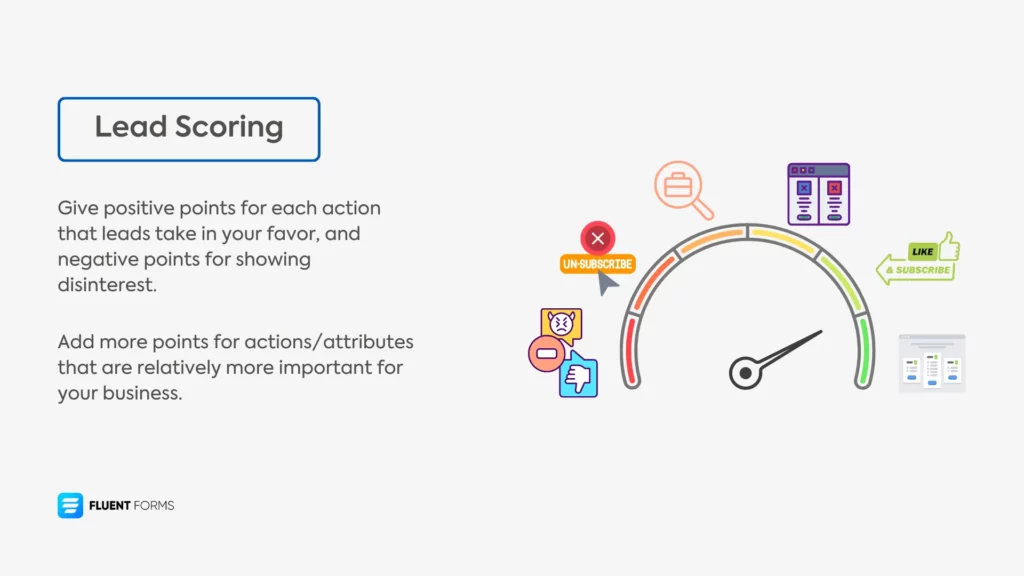
Lead scoring is a method used to rank prospects based on how likely they are to convert into paying customers.
It assigns numerical values (or scores) to each lead depending on various factors like demographics, behavior, engagement with your business, and other attributes.
With a proper lead scoring technique in place, you can easily figure out how ready each lead is to buy. It helps you differentiate among different kinds of sales leads. By categorizing leads, your marketing and sales teams can focus their efforts on high-value prospects while nurturing lower-scoring leads until they’re ready to make a purchase.
Simply put, lead scoring helps prioritize leads to maximize productivity and drive a higher conversion rate. It improves the efficiency of your sales cycle by streamlining your sales process.
Predictive vs. manual lead scoring
When it comes to implementing lead scoring, businesses typically choose between predictive and manual approaches depending on their teams and how vast their customer base is.
Predictive lead scoring
Predictive lead scoring is mostly done using tools. The tools use machine learning and AI to analyze large datasets to find patterns among the successfully converted leads. Next, it looks for the same patterns among your leads to identify how close they are to making a purchase.
This automated lead scoring method saves you a lot of time and resources, especially if you want to scale up your business without adding to your team members’ workload.
Besides, since the predictions are data-driven, the results are more accurate. However, this only applies provided you have quality datasets at your disposal. The data you deliver for analysis must be accurate, complete, up-to-date, reliable, and in alignment with your purpose.
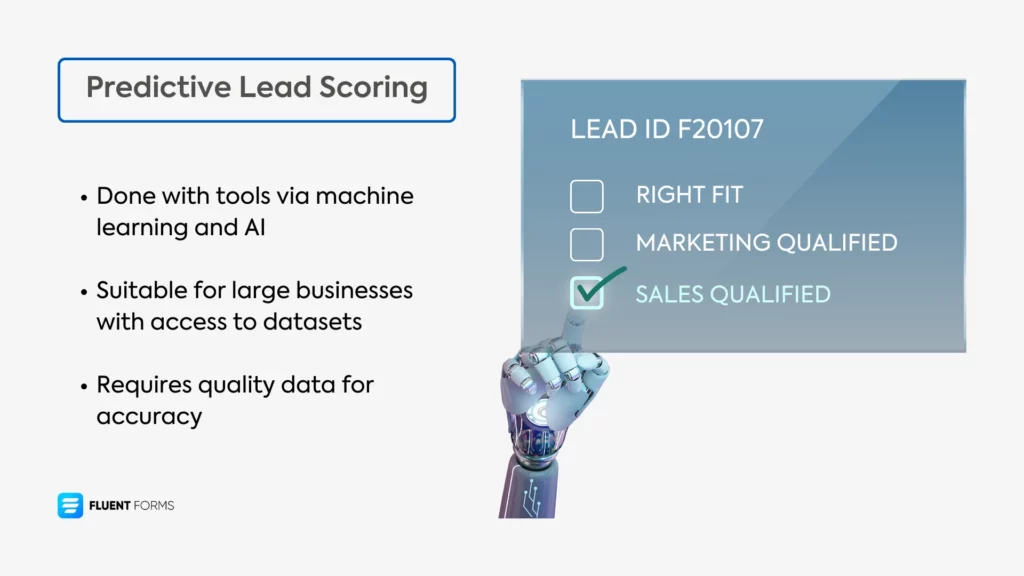
Manual lead scoring
Manual lead scoring involves assigning values to leads based on criteria set by your sales and marketing teams. This process offers more flexibility to customize your approach. Your team gets to define the boundaries and scopes of different scoring criteria specific to your business needs.
This process is time-consuming and more suitable for small businesses since they have fewer leads. However, your team gets to learn more about your leads by analyzing their data manually.
To reap the most benefits from manual lead scoring, you have to ensure minimal error or bias.
Why do you need lead scoring
Not every lead is ready to buy right away.
For example, a lead comes across the educational content on your website and subscribes to receive similar content via email. If you send them your pricing in the first email, they’re going to unsubscribe.
This poses a critical problem for your business. You’re losing leads and prospects along the way because you don’t know whom to present the sales pitch to, or whom to offer more tailored resources.
Fortunately, the lead scoring process steps in as your savior. You implement lead scoring to categorize your leads so you can take a targeted approach with each category using tailored content or pitch. This way your team can allocate resources and time even more efficiently.
Here are the key benefits of lead scoring at a glance:
Better sales and marketing Alignment: Clear scores help sales and marketing teams work toward shared goals.
Maximized conversion rates: By prioritizing hot leads, your team can focus on prospects more likely to convert.
Efficient resource & time allocation: High-scoring leads receive more immediate attention while lower-scoring leads can be nurtured over time.
Personalization: Knowing where leads stand in their buyer’s journey brings the opportunity to offer them tailored communication.
Lead scoring criteria
To develop strong lead-scoring models, you’ll need defined parameters. To tailor those parameters to your business you need a clear understanding of your customer data since not every information is equally beneficial to your business.
For example, if your product/service can be bought/sold online irrespective of your prospects’ location, then you don’t have to limit your marketing efforts to a particular geographic location. However, you might still utilize location information to tailor your approach.
A real-life instance could be Netflix. You can subscribe to Netflix and access their content from anywhere, yet they single out what’s popular at your location in real time to give you a better experience.
If your business doesn’t have Netflix’s budget or resources, you can use the location information to prioritize areas where most of your clients are from and target ads to those locations.
Here are the different types of customer data within four main categories you need to consider when building your lead scorecard. Take note of which information is most crucial for your business when you go through this section. You can’t ask leads for too much information or you’ll risk looking suspicious.
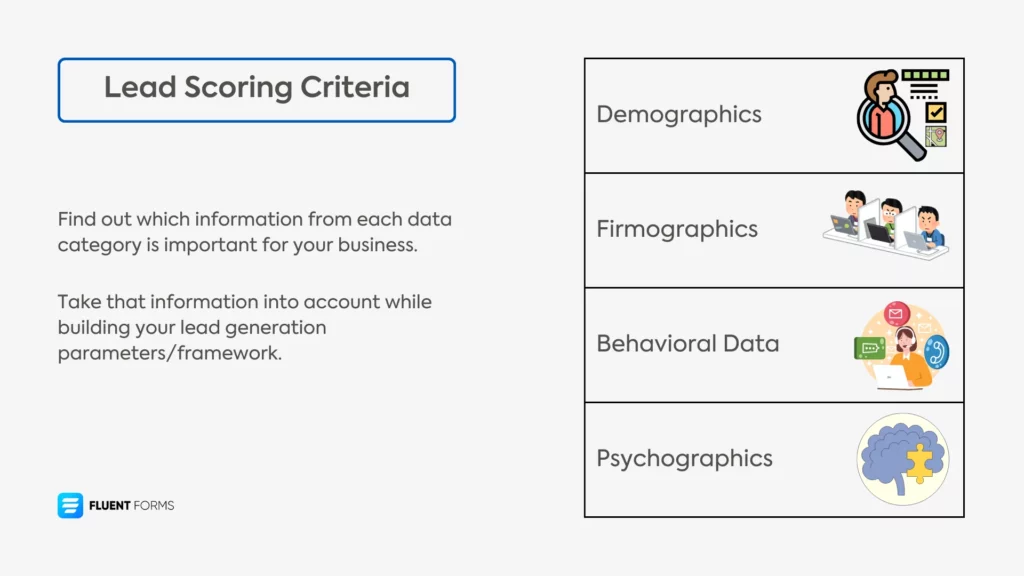
1. Demographics
Demographic data helps you filter your customers by external factors like age, race, gender, education level, occupation, geographical location, income level, type of vehicle they drive, etc. This data gives you insights into who your leads are as an individual.
These characteristics include:
Age: Certain products or services may appeal more to specific age groups.
Gender: In some industries, gender may influence purchasing decisions or preferences.
Job title & income: A higher-ranking role, such as a manager or executive, can indicate decision-making power or affordability, making them a more valuable lead.
Location: Urban, suburban, or rural environments can shape needs and purchasing habits.
Analyze this information of your customers. See which age group most of your customers fall under, where they live, how much they make, etc. When you get a standard range for each group, compare your leads’ information to the standard. The closer they are to the standard, the likelier they are to convert.
2. Firmographics
Firmographics are information on a company. They’re crucial for B2B businesses, as they provide insight into the lead’s company profile. This includes:
Industry: Certain industries may align better with your product or service than others.
Company size: Information on a company’s client base and number of employees. Larger companies might require enterprise-level solutions, while smaller businesses may prefer cost-effective options.
Annual revenue: This helps assess the company’s budget and purchasing power.
For instance, an enterprise software provider might prioritize leads from companies with more than 200 employees and significant annual revenues. Those companies are the most promising leads as they are more likely to invest in large-scale, long-term solutions.
3. Behavioral information
Behavioral data offers insights into leads’ interaction with your brand and their level of interest in your products/services. Key behavioral information include:
Website visits: Frequent visits or time spent on detailed product pages can signal strong interest.
Email engagement: High open and click rates, or personal responses suggest an active interest in learning more.
Event attendance: Participation in webinars, workshops, or trade shows shows a deeper involvement.
Social media interactions: Likes, shares, comments, or direct messages reflect varying levels of engagement.
A lead who visited your pricing page more than once, opened emails, and requested a product demo is far more likely to convert than someone who only glanced at your homepage. Behavioral data helps you focus on the most engaged prospects.
4. Psychographics
Psychographics offer a deeper understanding of the mindset, attitudes, and motivations of your leads. It tells you why a customer behaves the way they do or makes a certain purchase.
With this data, you can group your customers according to their motivations, values, priorities, personalities, lifestyles, interests, attitudes, opinions, etc. This type of data evaluates:
Pain points or challenges leads face: Understanding what problems they face allows you to tailor your messaging.
Interests aligning with your product/service: Leads who naturally resonate with your offerings are more likely to convert.
Value alignment: Leads who share similar values with your brand may be more loyal over time.
For example, if your product solves a common challenge for small business owners—such as managing cash flow—you can highlight this pain point in your outreach. Psychographic data helps you communicate better with your leads, they feel heard and valued and start to trust your brand.
The lead scoring model designed using information that leads explicitly give you (demographics, firmographics, etc) is known as explicit lead scoring, and the scoring model that gives points to leads based on actions they take (behavioral information) is implicit lead scoring.
Combine the information relevant to your industry and business to create a comprehensive lead scoring system. This will help you identify your most promising leads, and you’ll be converting them with precision in no time.
Lead scoring models: how to strategize yours
A lead scoring model helps you with a structured and organized approach to evaluating potential customers. With the right lead scoring model, you can prioritize your efforts and focus on the most promising leads. Here are some common approaches to lead scoring:
- Points-based scoring:
In this method, you assign numerical values, or points, to specific attributes and activities like a lead’s job title, company size, or engagement with your marketing materials (e.g., email clicks or website visits).
There has to be a predetermined highest value for each attribute. And the closest a lead is to that attribute, the more they score.
For example, if 5 years of experience in an industry is considered ideal and earns a prospect 10 points, then another lead with 4 years of experience should get 8 points.
It’s a highly customizable approach, allowing businesses to tailor scores based on what matters most to them.
Go for this model if you have a small/medium business. Start slow with a few criteria, and work your way up to more detailed scoring.
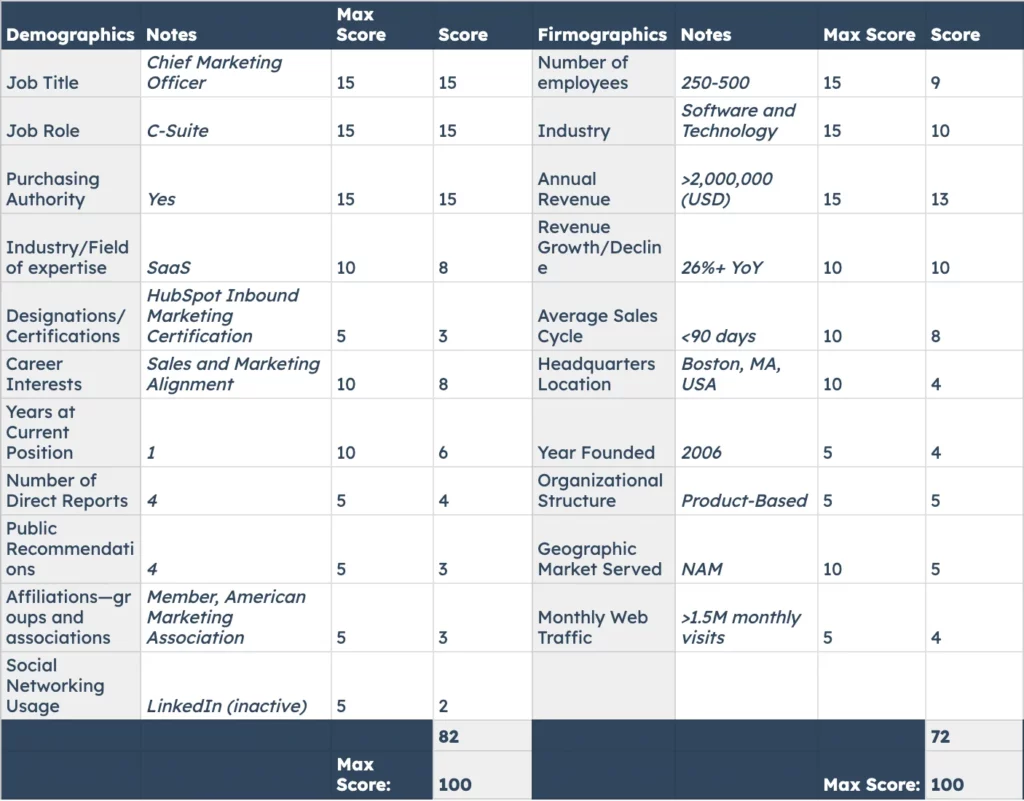
- Binary scoring:
This is a simpler approach that categorizes leads as qualified or unqualified based on specific criteria.
For example, a lead might be marked qualified if they ask about pricing or request a product demo. It’s a simple method ideal for businesses just starting with lead scoring.
- Predictive scoring:
This is an advanced approach that requires using AI and machine learning. This is suitable for large sets of data that are hard to process manually. There are tools for predictive scoring to analyze data patterns and predict the likelihood of a lead converting into a customer.
Choosing the right model depends on your business type, goals, and resources. A points-based or binary scoring model may suit businesses with simpler processes, while predictive scoring is ideal for large businesses that need to process large datasets with accuracy.
Lead scoring best practices
An effective lead scoring system is essential for identifying your most promising prospects. It needs careful planning, consistent refinement, and effective communication between teams. Follow these best practices to create a lead scoring system suitable for your business.
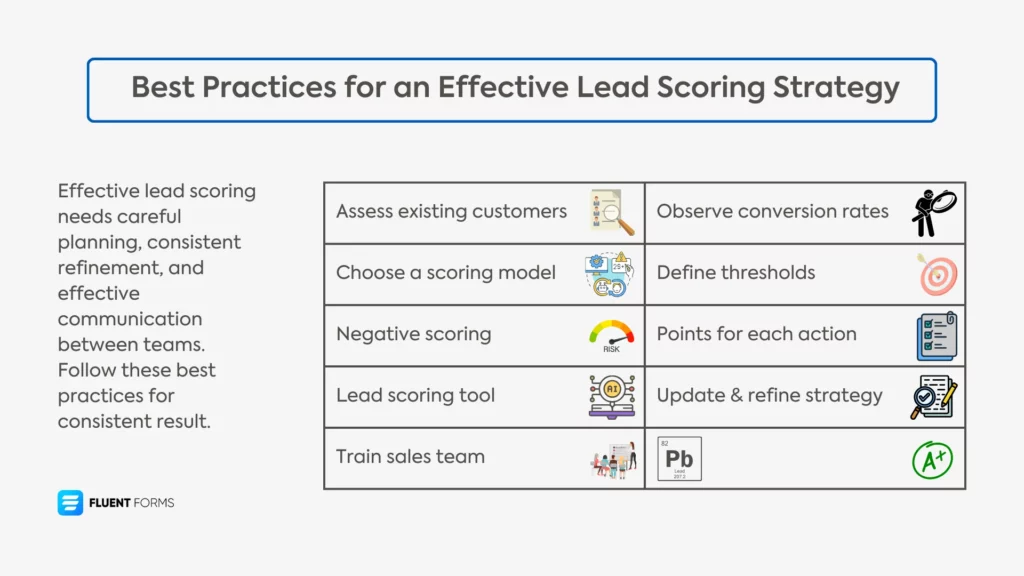
1. Assess your existing customers
First, analyze your ideal customers, both current and past. Observe their demographics, behaviors, and engagement to look for patterns or intersection points. Assign the highest point to the group/range that you find in most of your customers. In addition, consider which cases led to the highest profit.
2. Choose a scoring model
Decide which scoring model fits your business needs. If you manage a small or medium business, choose the points-based model. It allows you the flexibility to assign suitable numerical values to specific actions and attributes, like a five for opening emails or a ten for downloading content.
If you own a large business that generates tons of leads on a regular basis, use predictive lead scoring tools. It will help you identify patterns and prioritize the leads that are most likely to convert. Moreover, it also negates the risk of error that manually scoring a large number of leads might cause.
3. Implement negative scoring
While most actions taken by a lead regarding your company are beneficial for your business, some are quite the opposite. That’s why you need to introduce a negative lead scoring.
Assign negative points to a lead for activities that indicate low buying intent. These might include unsubscribing from emails, visiting your “Careers” page, making negative comments on social media, or not visiting your website in the last six months.
This helps your sales team focus their efforts on the leads who are genuinely interested in your product or service.
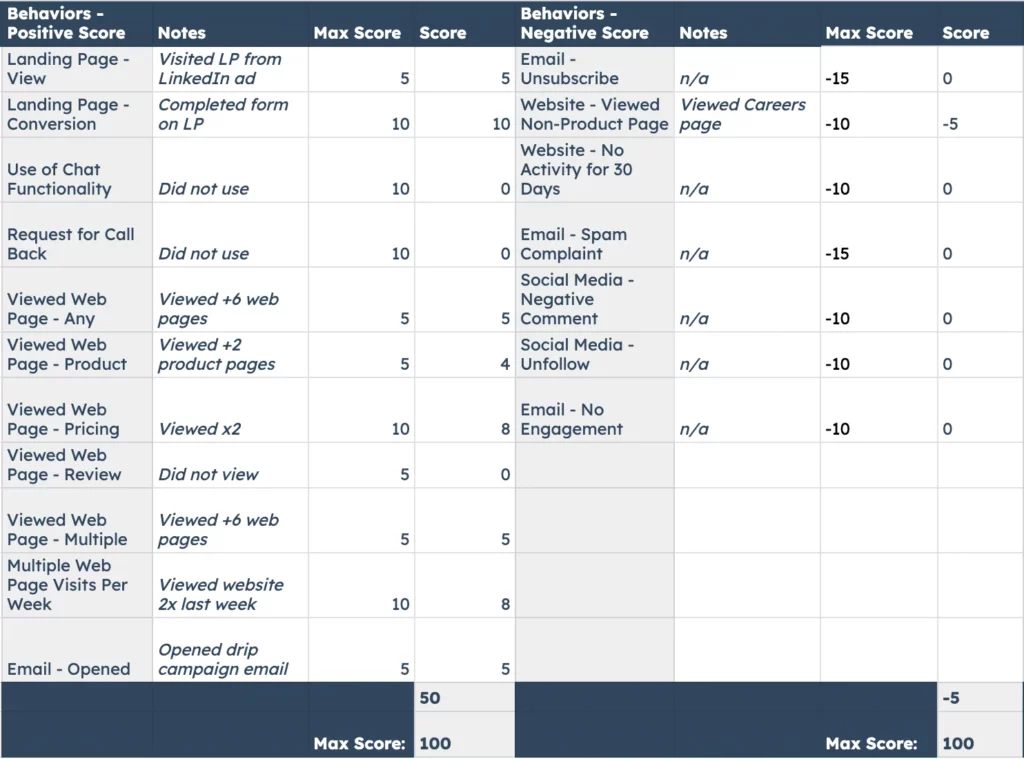
4. Consider using a lead scoring tool
Manually scoring leads can be time-consuming. And prone to error. If you have a large number of leads incoming, you should automate the process. You can use trusted tools like HubSpot, Marketo, or Salesforce.
These platforms use algorithms to assign scores based on predefined criteria. It saves time as well as ensures accuracy. Some tools also integrate with your CRM tools so that you can streamline your sales process.
5. Train your sales team
Make sure that your sales team is well-informed on how the lead scoring process works. They need to be able to interpret the scores. This is how they can prioritize their outreach accordingly.
Provide training sessions or resources to explain how the scoring aligns with your sales process and how it can help them focus on high-potential leads.
6. Closely observe the conversion process
Monitor how well high-scoring leads are converting into customers.
Do high scores in certain criteria consistently result in sales? Make those a constant, and mark them as high-value criteria.
If your high-ranking leads aren’t converting in time, review your strategy and readjust some parameters. Use data to refine your process, and check if the new model is bringing results.
7. Define sales-qualified lead criteria/threshold
Work with your sales team to establish what qualifies a lead as sales-ready.
Define a minimum overall score and a separate minimum score in the most important data category for your business that indicates a lead is ready to be handed off to sales.
Moreover, define other thresholds crossing which makes a lead qualify for personalized nurturing.
8. Assign points to every action and attribute
Create a detailed lead scorecard so every aspect is taken into consideration.
Assign points to a wide range of actions and attributes, such as visiting product pages, attending webinars, or engaging with your social media accounts.
Don’t forget to include demographic information like job title or company size if they are relevant to your ideal customer profile.
9. Regularly update and refine your strategy
Lead scoring is not a one-time thing. You need to conduct routine audits for consistent results. Regularly check in with your marketing and sales team for feedback on how your lead scoring model is performing.
Furthermore, continuously refine your criteria and scoring models based on new data, market trends, and evolving customer behaviors.
With these steps in place, you’ll be right on track to building a lead scoring strategy that identifies the best leads for your business, optimizes your sales efforts, and ultimately drives more conversions.
What’s next
Lead management is a complex process, mostly because leads don’t come across your business at the same point of their buyer’s journey. At any given time you have cold, warm, and hot leads in your sales funnel as this is an ongoing process.
Lead scoring is the method you use to categorize these leads and tag them with the right label. Streamlining your marketing and sales process with proper lead scoring saves you time and increases your sales efficiency.
Follow the criteria and best practices in this blog to design the perfect lead scoring model for your business for maximum conversion rates.
Let us know your thoughts on lead scoring and don’t hesitate to ask in case you have any questions.

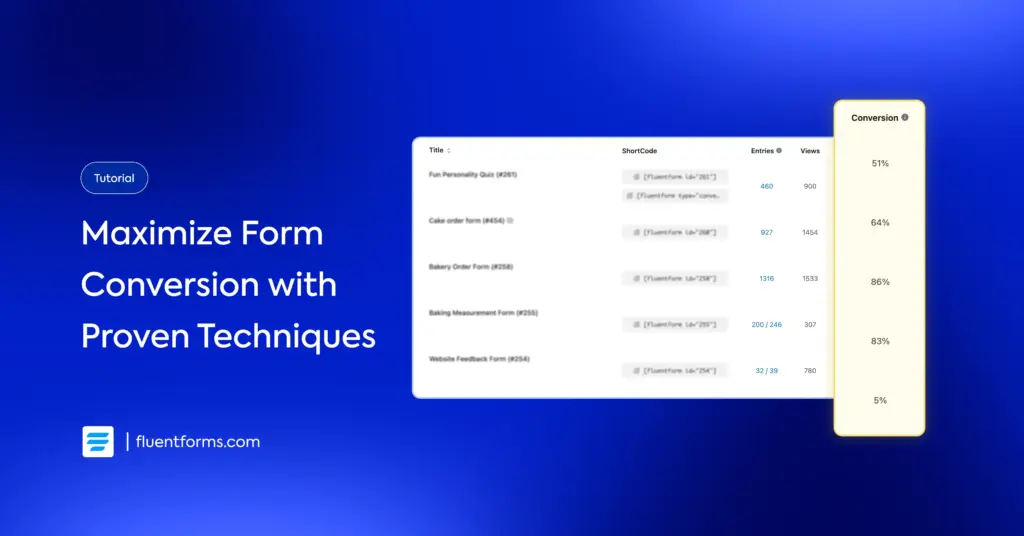
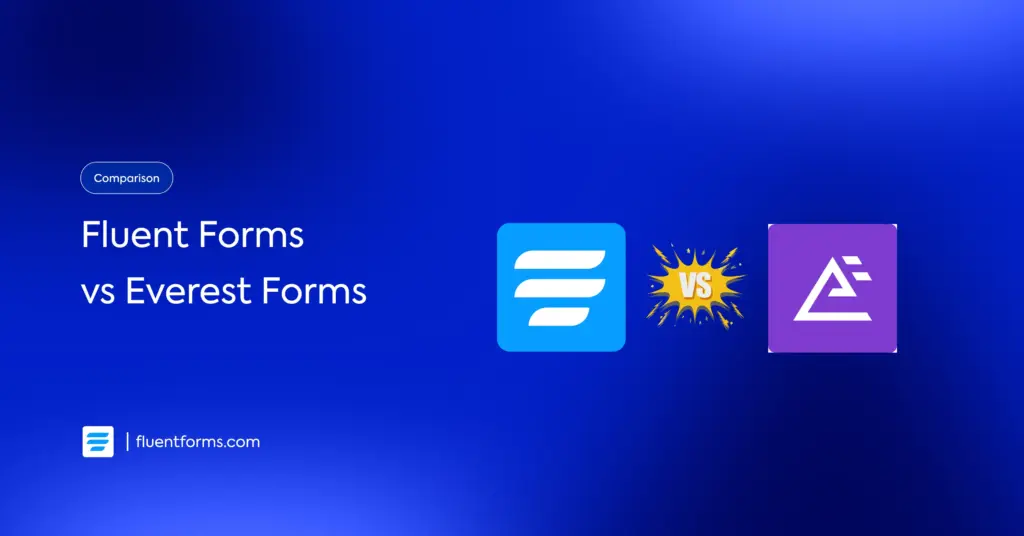




Leave a Reply